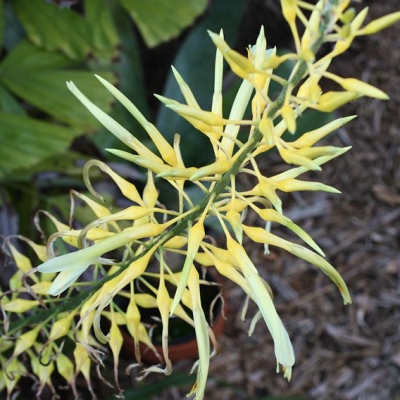| Home |
Strange Wonderful Things
Rare and exotic plants
|
 |
Pitcairnia xanthocalyx

Germinating the seeds
When to plant -- Plant your seeds when you receive them for best germination.
Getting started -- You may
either plant them all in a single container, or use several smaller containers
and plant a few seeds in each. Either way, use pots with drainage holes
For soil, use a well draining mix that is high in organic matter. A typical mix is 2 parts potting soil to 1 part
perlite or coarse sand. An alternate mix is 1 part perlite to 1 part coir fiber, with some slow-release fertilizer mixed in.
Fill the pots with soil and place a seed or 2 on the surface.
- If you have
long-fibered sphagnum moss (not ground peat moss),
sprinkle a thin layer over the pot, to retain
moisture around the seeds while allowing light to reach them, which aids
germination.
This photo shows how much moss to use.
- If you do not have sphagnum moss,
sprinkle a very thin layer of your soil mix over the pot (about 1/16th of an
inch / 2 mm). It does not need to completely cover the surface - it's
just to maintain moisture around the seeds.
Next add water until everything is evenly moist (but not soggy).
Until the seeds sprout, ensure that the soil surface always stay moist. A plastic dome or bag may be used to maintain
near-100% humidity, but leave it open a crack to allow some fresh air in. You may need to drip a few drops of water over the seeds
once or twice a day to keep them moist.
The ideal temperature for germination is between 65 to
80 degrees F (18-27°C). A little cooler at night is ok.
Avoid letting them get too warm. I recommend placing a
minimum/maximum thermometer near the pots,
especially if using a heating mat.
The seeds need some light to germinate. A fluorescent
or LED bulb kept 4 inches (10 cm) away provides the right amount of
light. Protect from direct sun.
They should start germinating in 3 to 5 weeks and continue for another few weeks. Continue keeping the soil surface moist until they are a month old; then you may
allow the soil surface to dry between waterings. Give bright light but avoid giving direct sun until they are a few weeks old.
Fertilizing -- For the first
2 months, feed weekly with a small amount of diluted (1/8 strength) liquid fertilizer.
Hydroponic fertilizer
is ideal for seedlings, because it is easily absorbed and contains all essential
nutrients.
After 2 months, you may switch to a granular fertilizer if you prefer.
Choose one with micronutrients, and follow the dosage on the package.
Growing onward...
Lighting -- It is happiest in part-sun, with some protection from strong afternoon sun. Acclimate
them to increased sun levels
slowly to avoid burning.
Transplanting -- When your plants are 2-3 months old, you may gently transfer them to a larger pot. For the first week after transplanting, shade from sun, and
give no liquid fertilizer.
Watering -- Aim to keep the soil evenly moist most of the time (but not soggy). You may use a moisture meter probe to monitor the moisture levels down in the root
zone. Give less water in cooler temperatures, and keep relatively dry when temperatures drop approach freezing.
Climate -- Adult plants tolerate a wide variety of temperatures, reportedly handling the low 20s (-6°C) as well as high heat.
But for the first 9-12 months, i recommend being cautious about exposing the
plants to temperature extremes, especially freezing conditions.
Have fun growing them!
- Jeff
Strange Wonderful Things
| Home |
Strange Wonderful Things
Rare and exotic plants |

|
| Entire site Copyright 2003-2025 by Strange Wonderful Things, except as noted |
|


